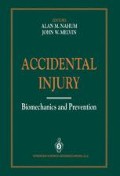Abstract
One of the primary contributors to the injury problem is the automobile crash. Information collected about crashes has the potential to aid researchers in understanding the mechanisms of injuries and to point the way to possible solutions. Unlike the laboratory experiment, in which all variables are measured, held constant, or monitored, most variables in an automobile collision are not monitored and are changing rapidly.
Access this chapter
Tax calculation will be finalised at checkout
Purchases are for personal use only
Preview
Unable to display preview. Download preview PDF.
Bibliography of Crash Data Files and Related Documentation
American Association of Motor Vehicle Administrators, American National Standards Institute, and National Highway Traffic Safety Administration, Data Element Dictionary for Traffic Records Systems. Report No. ANSI D20.1–1979/ DOT-HS-805–226. American National Standards Institute, New York, March 1980.
Association for the Advancement of Automotive Medicine. The abbreviated injury scale, 1985 Revision, AAAM, Des Plaines, IL, 1985.
Collision deformation classification. SAE J224a, Society of Automotive Engineers.
CRASH3 User’s guide and technical manual. DOTHS-805–732, January 1981.
Critical automated data reporting elements. National Highway Traffic Safety Administration, Fed Reg 55(84):18220, May 1, 1990.
Evans L. Traffic safety and the driver. Van Nostrand Reinhold Co, New York, 1991.
Fatal accident reporting system coding and validation manual. National Highway Traffic Safety Administration, National Center for Statistics and Analysis, 1991.
Hight PV, et al. Barrier equivalent velocity, delta-V, and crash 3 stiffness in automobile collisions. In Field accidents: data collection, analysis, methodologies, and crash injury reconstructions, Society of Automotive Engineers, Warrendale, PA, 1985.
National Accident Sampling System, General estimates system, analytical user’s manual. National Highway Traffic Safety Administration, National Center for Statistics and Analysis, 1989 File.
National Accident Sampling System, General Estimates System. A review of information on police-reported Traffic crashes in the United States. National Highway Traffic Safety Administration, National Center for Statistics and Analysis, 1989.
National Accident Sampling System, Crashworthiness data subsystem, analytical user’s manual. National Highway Traffic Safety Administration, National Center for Statistics and Analysis, 1989 File.
National Accident Sampling System, Crashworthiness data subsystem, Data collection, coding, and editing manual. National Highway Traffic Safety Administration, National Center for Statistics and Analysis, 1989 File.
National accident sampling system, injury coding manual. National Highway Traffic Safety Administration, National Center for Statistics and Analysis, 1988 File.
Manual on classification of motor vehicle traffic accidents,ANSI D16.1 National Safety Council, 1990.
O’Day, James, Waissi, Gary R Worldwide Accident Data Standardization. The UMTRI Research Review, 17(6) May–June 1987.
Trauma Registry Users’ Manual. Centers For Disease Control, Atlanta, Georgia, July 1990.
Editor information
Editors and Affiliations
Rights and permissions
Copyright information
© 1993 Springer Science+Business Media New York
About this chapter
Cite this chapter
Compton, C.P. (1993). The Use of Public Crash Data in Biomechanical Research. In: Nahum, A.M., Melvin, J.W. (eds) Accidental Injury. Springer, New York, NY. https://doi.org/10.1007/978-1-4757-2264-2_3
Download citation
DOI: https://doi.org/10.1007/978-1-4757-2264-2_3
Publisher Name: Springer, New York, NY
Print ISBN: 978-1-4757-2266-6
Online ISBN: 978-1-4757-2264-2
eBook Packages: Springer Book Archive

